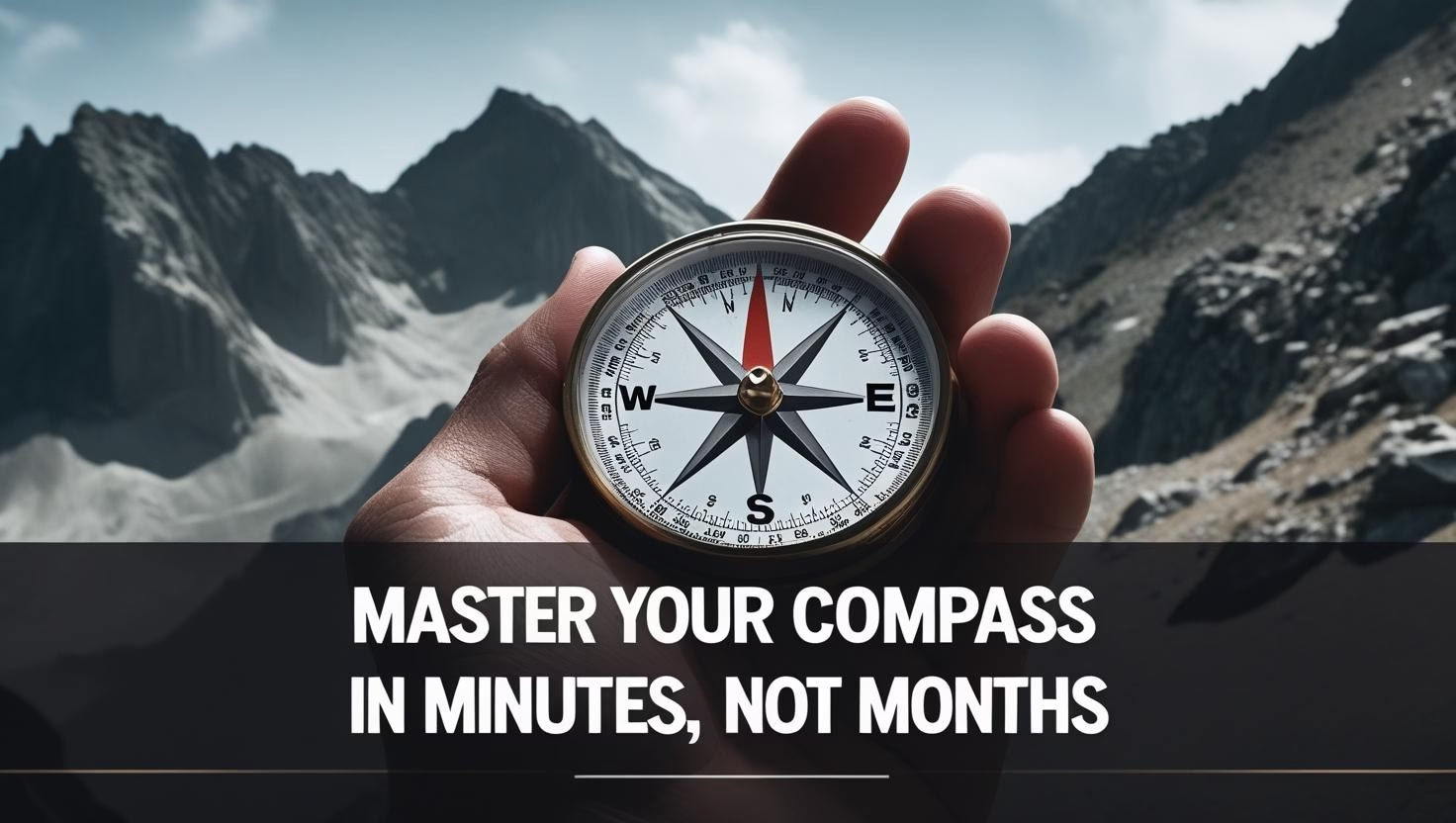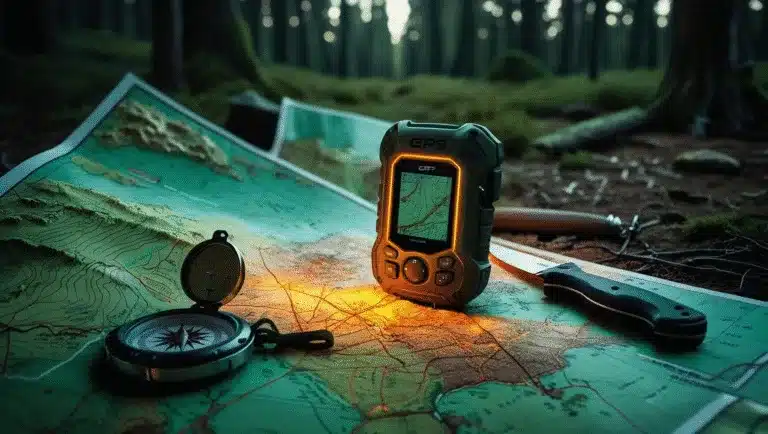
How to Read a Compass in 60 Seconds (No GPS Needed)
Master Your Compass in Minutes, Not Months
If you think learning how to read a compass requires a survival school diploma and a ceremonial handshake with Bear Grylls, think again. You can nail the basics in less time than it takes your camp coffee to boil.
Here’s the reality: when your hiking buddies disappear over the ridge, hesitation is the enemy. One minute you’re scanning the horizon like a seasoned explorer; the next you’re spinning the bezel like you’re trying to crack a vault—while your friends are halfway to camp, eating the snacks you could’ve been stealing.
Navigation isn’t about looking impressive—it’s about being effective. With the right approach, you’ll go from “Uh… I think it’s that way?” to “Follow me, I’ve got this” in under a minute. The best part? You’ll join the elite 10% of outdoor folks who can navigate without a glowing screen. No GPS? No problem. Just you, a compass, and the confidence to find your way home even if every satellite calls it quits tomorrow.
What Is Compass Navigation, Really? (and Why Learning How to Read a Compass Still Matters)
Compass navigation is the ancient-but-still-awesome art of using a magnetic needle to point you toward a direction — and then keeping that direction until you get where you’re going.
It’s not about fancy orienteering maps, military land nav courses, or being able to calculate azimuths down to the degree (though those skills are great).
This is about quick, actionable, “which way do I walk” navigation. The kind that works:
- When your phone’s dead.
- When you’re socked in by fog.
- When the “clearly marked trail” apparently only exists in the imagination of the park ranger.
If you want to go deeper into the full skillset, check out my guide:
Compass Skills for Beginners: Navigate 2025 Without Getting Eaten (or Lost)
The 60-Second Compass Method: How to Read a Compass Without Looking Like a Lost Tourist

Step 1: Hold It Flat
- Keep your compass level in your palm, about chest height.
- If the needle shakes or sticks, you’re either tilting it or standing next to something metal. That includes your belt buckle, a knife, your car, or — my personal favorite — the tailgate of your truck. Step away from anything magnetic or metal before you trust the reading.
Step 2: Point the Arrow Where You Want to Go
- Aim the bold direction-of-travel arrow on the baseplate at your target.
- This might be a mountain peak, a trail sign, or that suspicious-looking cluster of pine trees you swear hides the campsite.
- Pro tip: This is NOT the red magnetic needle. Don’t aim the needle at the thing you want — aim the arrow.
Step 3: Box the Needle
- Turn the rotating bezel until the red needle is inside the orienting arrow outline. That’s “red in the shed.”
- Now your direction-of-travel arrow is pointing exactly where you should walk to keep on course.
For a more advanced breakdown of this, see my post coming out Monday August 11, 2025:
Magnetic Bearings, Dummy: A Real-World Navigation Guide
Step 4: Walk
- Move forward, keeping the needle in the box. If it drifts, so will you.
- Pick a landmark in line with your arrow, walk to it, then recheck your compass from there.
Why This Works So Fast
Most people overcomplicate learning how to read a compass by trying to cram every navigation skill into their brain before they’ve ever taken it out of their pocket. The truth? You only need this simple 4-step process to start moving confidently in the right direction.
Once you’ve got the basics down, you can level up to:
- Setting a bearing to a specific degree.
- Adjusting for magnetic declination.
- Using a map and compass together for pinpoint accuracy.
If you want to see how a compass really shines when paired with a map, check out my Building a DIY Land Nav Kit That Fits in Your Glovebox post. That’s where “how to read a compass” graduates to “how to own the backcountry.”
Common Mistakes People Make When Learning How to Read a Compass
- Following the Needle Instead of the Arrow
- Standing Too Close to Metal
- Walking Without Landmarks
- Forgetting to Recheck the Compass
Pro Tips to Level Up Your Compass Skills
- Practice in Familiar Areas: Build muscle memory where you can’t actually get lost.
- Combine with a Map: Even a basic topo map multiplies your options.
- Learn Declination: It’s the difference between magnetic north and true north.
Gear Recommendations

If you’re going to commit to learning, invest in a compass worth trusting:
- Suunto MC-2 – Great all-around.
- Silva Ranger – Reliable, simple.
- Cammenga 3H Tritium – Military-tough. (My personal compass)
Why Even Bother in the GPS Era?
Because when your phone’s dead, your GPS freezes, or your fancy smartwatch decides it’s “out of service,” you’ll still need to know where you’re going. A compass never loses signal, never needs charging, and doesn’t panic in bad weather—it just quietly does its job, no excuses.
- Batteries Die
- Signals Fail
- Gear Breaks
Your compass doesn’t care about weather, battery level, or whether your phone just took a swim.
Field Test Challenge
This weekend, try this:
- Pick a landmark about 300–500 yards away.
- Use the 60-second method.
- Walk to it using intermediate landmarks.
- See how close you get.
Wrapping Up: Why This Matters
Knowing how to read a compass in under a minute isn’t just a cool outdoor party trick — it’s a survival skill that can keep you found when everything else fails. GPS batteries die, phone signals vanish, and even the best trail markers can disappear in fog, snow, or thick brush. Learning how to read a compass means you’re never fully at the mercy of technology.
It works in the rain, in the dark, and in places no satellite can reach. Mastering how to read a compass ensures you’re not just following a path — you’re confidently navigating it, whether that’s back to camp, toward a hidden water source, or straight out of trouble. In the outdoors, knowing how to read a compass isn’t just comforting — it’s life-saving.
Heads-Up, Fellow Preppers:
Some links in this post are sponsored or affiliate links. If you click and buy, I may earn a small commission—enough to restock my peanut butter and maybe add one more can of chili to the stash. I only recommend gear I trust, use, and would hide in a bug-out bag.






